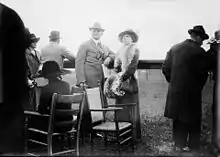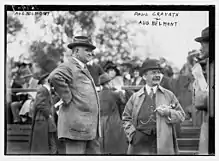Paul Drennan Cravath
Paul Drennan Cravath (July 14, 1861 – July 1, 1940) was a prominent Manhattan lawyer and presiding partner of the New York law firm Cravath, Swaine & Moore.[1][2] He devised the Cravath System, was a leader in the Atlantist movement, and was a founding member and director of the Council on Foreign Relations.
Paul D. Cravath | |
|---|---|
.jpg.webp) | |
| Born | July 14, 1861 Berlin Heights, Ohio, U.S. |
| Died | July 1, 1940 (aged 78) Locust Valley, New York, U.S. |
| Nationality | American |
| Education | Oberlin College (AB) Columbia University (LLB) |
| Occupation | Lawyer |
| Known for | The Cravath System |
| Height | 6 ft 4 in (1.93 m) |
| Spouse | Agnes Huntington (1892–1940) |
| Children | Vera Agnes Huntington Cravath |
| Relatives | Rev. Erastus Milo Cravath (father) Georgia Laura White (cousin) |
| Signature | |
Early life and education
Cravath was born July 14, 1861, to Ruth Anna Jackson, a Pennsylvania Quaker, and abolitionist Erastus Milo Cravath, a descendant of French Huguenots who was a co-founder and president of Fisk University.[3]
Cravath graduated from Oberlin College in 1882, where he was considered both "brilliant" and a prankster. Oberlin also awarded him an honorary A.M. degree in 1887.[4]
He embarked on the study of law in 1882, which was interrupted, three months later, when he contracted typhoid fever. Recovered, Cravath worked for the Globe Oil Company, a subsidiary of Standard Oil, as a salesman, then resumed his law studies in 1884, financed by his earned wages. At school, he worked as a tutor; vacation time was spent in Minnesota, working on his father's farm and visiting Quaker relatives. Cravath graduated cum laude from Columbia Law School in 1886; he was awarded the school's first Municipal Law prize.[4]
Law career
While at Columbia, Cravath was a law student with the firm of Martin & Smith, and was admitted to the New York State Bar Association in June 1886.[4] An early client was George Westinghouse,[5] who was being sued by the Edison Illuminating Company for infringing on Thomas Edison's incandescent lamp patent.[6]
He joined the law firm of Blatchford, Seward & Griswold in 1899. His book of business included Bethlehem Steel, Baltimore and Ohio Railroad, Kuhn, Loeb & Co., Chemical Bank, E. R. Squibb & Sons, Columbia Gas & Electric, and Studebaker Corp.[7] His name was added to the firm's moniker in 1901.[8]
Cravath was the authoritative head of the firm from 1906 until his death in 1940, and his formal statement of his conceptions of proper management of a law office still controls its operations.[9] Cravath, Swaine & Moore endures as a leading law firm, and celebrated its 200th anniversary in 2019.[10]
Cravath System
His law firm growth and operating structure remains widely known today as the Cravath System. White Shoe author John Oller credits the Cravath System as the model adopted by virtually all white-shoe law firms in the early 20th century, 50 years before the phrase white shoe came into use.[11] The Cravath System has been partially adopted by most large law firms.[12][13]
Foreign policy
As a leader of the Atlanticist movement, Cravath was influential in foreign policy. The organization was composed of influential lawyers, bankers, academics, and politicians of the Northeastern United States, who committed to a strand of Anglophile internationalism.[14] For Cravath, the First World War served as an epiphany, building a deep concern with foreign policy that dominated his remaining career. Fiercely Anglophile, he demanded American intervention in the war against Germany. His goal was to build close Anglo-American cooperation that would be the guiding principle of postwar international organization.[14]
He was one of the founding officers of the Council on Foreign Relations in 1921. The founding president of the CFR was John W. Davis, a name partner of the law firm Davis Polk & Wardwell, while Cravath served as the inaugural vice-president.
Cravath was awarded the Distinguished Service Medal by General Pershing, in 1919, for "exceptionally meritorious conduct and services during the war."[15] He was also made a knight of the Legion of Honor by the French government, which also honored Cravath with a "special war cross".[16]
Fisk University
Cravath spent most of his childhood in Nashville, Tennessee, where his father, Reverend Erastus Milo Cravath, was a co-founder of Fisk University, and served as its first president from 1875 to 1900. Cravath later served as a member and chairman of the Fisk Board of Trustees[17] for over 30 years, until his death in 1940.
Personal life


In 1892, he married the opera singer Agnes Huntington. Their daughter, Vera Agnes Huntington Cravath (1895–1985), was born on August 28, 1895.[18] Reported on page one of The New York Times, the couple became legally and permanently separate, in 1926, while remaining married. Their daughter, then separated from her first husband, moved in with her father until her second marriage the following year.[19][18]
Vera Cravath married at least twice: to Lt. James Satterthwaite Larkin, about 1917, with whom she had a son, Adrian Cravath Larkin (who died in 2014, aged 94), then to William Francis Gibbs, in 1927, with whom she had two sons.[20] She died in Rockport, Massachusetts, in July 1985.[18]
Cravath was a director of the New York Symphony Society and the Juilliard School of Music,[21] and became chairman of the Metropolitan Opera in 1931 and was subsequently profiled by The New Yorker in its first January 1932 issue.[22] He died in 1940.[7]
In popular culture
A fictionalized Cravath (name unchanged) is the protagonist in Graham Moore's 2016 historical novel The Last Days of Night, which received generally positive reviews,[23][24] As of 2016, a cinematic adaptation of the "historical thriller"[25] was in development, starring Eddie Redmayne as Cravath.[26][27]
References
- "Presiding Partners 1906-1940".
- Richard E. Mendales (July 1, 2001). "Paul Drennan Cravath". American National Biography. Retrieved September 16, 2008.
- A History of Fisk University, 1865-1946, by Joe Richardson, University of Alabama Press, 1980, pages 2–4. ISBN 0-8173-0015-5
- The Cravath Firm and Its Predecessors, 1819-1947, by Robert T. Swaine, The Lawbook Exchange, Ltd., 1978, pages 585-586.
- Blair, Rebecca (August 15, 2016). "Cravath Lawyer Spotlighted in Book, Movie with Eddie Redmayne". Law.com. Retrieved October 9, 2018.
- Dewey, Katrina (August 29, 2016). "Consider The Lawyer: How A Young Paul Cravath Took On Edison". Lawdragon. Retrieved July 24, 2017.
- "Died". Time magazine. July 8, 1940. Archived from the original on February 9, 2009. Retrieved December 8, 2008.
Paul Drennan Cravath, 78, massive, magisterial corporation lawyer, head of one of the nation's greatest law firms, Cravath, de Gersdorif, Swaine & Wood; of a heart attack; in Locust Valley, L. I.
- "Cravath, Swaine & Moore LLP" (PDF). Archived from the original (PDF) on August 28, 2006.
- Robert Taylor Swaine, The Cravath Firm and Its Predecessors (New York: Ad Press, 1946-48) Archived 2008-05-09 at the Wayback Machine
- Two Centuries of the Law: Cravath, Swaine & Moore exhibit, New-York Historical Society Museum & Library, March 22 – June 9, 2019. Retrieved July 12, 2020.
- Levinson, Marc (March 20, 2019). "White Shoe Review: Lawyering Up the 20th Century (book review)". Wall Street Journal. Retrieved March 22, 2019.
- William Henderson (2008). "Are We Selling Results or Résumés?: The Underexplored Linkage Between Human Resource Strategies and Firm-Specific Capital". SSRN 1121238.
- Henderson, Bill. "How most law firms misapply the "Cravath system"". Retrieved March 22, 2019.
- "Paul D. Cravath, the First World War, and the Anglophile Internationalist Tradition" by Priscilla Roberts, Australian Journal of Politics and History 2005 51(2), pages 194-215. ISSN 0004-9522
- "The Hall of Valor Project" Military Times, Sightline Media. Retrieved February 1, 2022.
- White Shoe: How a New Breed of Wall Street Lawyers Changed Big Business and the American Century by John Oller, Penguin Random House, 2019, page 263. ISBN 978-1-5247-4325-3 Retrieved November 29, 2021.
- Opportunity, Volumes 5-6, National Urban League, 1969, page 18.
- "Vera Cravath Gibbs, 89, Dies; Was Active in Opera Groups". The New York Times. July 30, 1985. Retrieved November 30, 2009.
Vera Cravath Gibbs, a former member of the board of the Metropolitan Opera Association and widow of William Francis Gibbs, the naval architect, died Saturday at her home in Rockport, Mass., following a heart attack. She was 89 years old.
- "PAUL D. CRAVATH AND WIFE SEPARATE" The New York Times, July 10, 1026, pages 1 and 3. Retrieved November 28, 2021.
- "LARKIN, ADRIAN CRAVATH" The New York Times, June 13, 2014. Retrieved November 28, 2021.
- "Cravath, Swaine & Moore The Early Cravath Firm: 1906-45" Encyclopedia.com. Retrieved November 28, 2021.
- "Public Man" by The New Yorker, January 2, 1932. Retrieved February 1, 2022.
- Hawley, Noah, "Fighting for the Light", The New York Times (September 4, 2016), p. BR7.
- Anderson, Patrick, "The Last Days of Night: The flaws of Thomas Edison, both real and imagined", The Washington Post (August 22, 2016)
- "Eddie Redmayne to star in 'The Last Days of Night'", Business Standard, July 31, 2016.
- Nolfi, Joey (July 25, 2016). "Last Days of Night: Eddie Redmayne to star in big screen adaptation of Graham Moore novel". Entertainment Weekly. Retrieved October 9, 2018.
- "The Last Days of Night - IMDb". IMDB. Retrieved October 9, 2018.
External links
- Works by or about Paul Drennan Cravath at Internet Archive
- "President Jones". Time Magazine. March 1, 1926. Archived from the original on January 31, 2011. Retrieved August 10, 2008.
- Cravath, Swaine & Moore